 |
American History
Mary of Agreda in America - Part II
Mary of Agreda Describes Her Travels
Margaret C. Galitzin
One of the most remarkable episodes in the early history of the Southwest is the bilocation of Mother Mary of Agreda to New Mexico and Texas. Her visits are confirmed by Fr. Benavides, the Franciscan Superior of the New Mexico Colony, in a report that describes the miraculous conversion of the Jumanos and their neighbors, who were catechized by the Lady in Blue. On the orders of the Archbishop of New Spain, he traveled to Spain in 1630 to deliver his report to the King and the Franciscan General.
On the first of August in 1630, Fr. Benevides arrived in Spain and reported to the Franciscan Father General, Fray Bernardino de Sena, Bishop of Viseo. The Father General had already been informed about the bilocations of Mother Mary of Agreda by her confessor. He had made a personal visit to her Convent eight years earlier, and she had spoken candidly to him about these marvels. He was favorably impressed with the Abbess, whose Convent was known for its piety, devotion and fidelity to the rule.
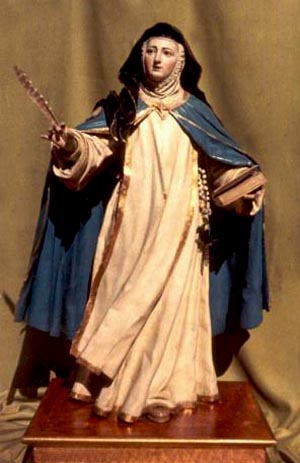
A statue of Ven. Mary of Agreda in the Conceptionist habit with its blue cloak |
The presence of Fr. Benevides in Spain was opportune to ascertain the veracity of her bilocations. He would be able to speak with Mother Mary of Jesus and ask her questions about the missions, the Indians, and the country that only someone who had been there could know. As an inquisitor and administrator of exceptional capacity, his opinion would have great weight in determining if Mary of Agreda was indeed the “Lady in Blue.”
In April of 1631, the Father General sent him to Agreda with the authority to oblige the Abbess under her vow of obedience to reveal to him everything relating to her miraculous visits to the Indians in the New World.
When Fr. Benevides reached Agreda, he first contacted the Provincial, Fr. Sebastian Marcilla, and the nun’s confessor, Fr. Andrés de la Torre. The three went to the Immaculate Conception Convent to question Mother Mary of Jesus. The account of their visit is documented by Fr. Benevides, who describes his first impression of the Abbess:
“Before saying anything else, I state that the said Mother Mary of Jesus, at present Abbess of the Convent of La Concepción, is almost 29 years of age, with a handsome face, a very clear and rosy complexion and large black eyes.
"The fashion of her habit …. is simple like ours, that is, of coarse brown sackcloth worn next to the body without any other tunic. Over this brown habit is one of heavy white sackcloth, with a scapulary of the same and the cord of our Father St. Francis. Over the scapulary is the rosary. They wear no shoes or other footwear except boards bound to their feet or some straw sandals. The mantle is of heavy blue sackcloth and the veil is black.” (Memorial, p. 479 - See footnote 1, Part 1)
It was this blue cloak of the Conceptionist Order that had inspired the Indians to call her the “Lady in Blue.”
The account of Mary of Agreda
Mary of Agreda obediently told the three priests all that concerned her visits to the Indians of America. Since she was a child, she said, she had been inspired to pray for the Indians in New Spain, whose souls would be lost unless they converted to the one true Faith.
Then Our Lord began to show her more distinctly in visions those provinces He desired to be converted. She observed the appearance of the people, their barbaric condition of life and customs, and their need for priests to instruct them in the Faith. In one of these visions, Our Lord singled out the Indians of New Mexico and told her he desired to convert them and other remote “kingdoms” of that area. This inspired her to pray and sacrifice even more fervently for these souls across the Ocean.
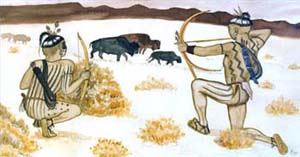
The Jumanos Indians (above) in southwest Texas were the first to tell about the lady in blue who visited them
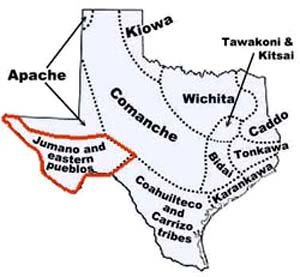 |
On one occasion, while praying for them, Our Lord unexpectedly transported her in a kind of ecstasy. Without perceiving the means, it seemed to her that she was in a different region and climate, amid those very Indians she had seen before only in visions. It seemed to her that she saw them with her eyes and felt the warmer temperature of the land. All her senses were affected by the change of place.
Then Our Lord commanded her to fulfill her charitable desires, and she began to preach the Catholic Faith to those people. She would preach to them in her own Spanish language, and the Indians understood her as if it were their own language. She could also understand what they said to her.
Returning from her trance, she found herself in the same place where it overtook her. This happened to her in 1620.
Subsequently, in the next 11 years that miracle was repeated more than 500 times, sometimes with three or four visits in one day. On these occasions, she said, it seemed to her “that through her words and the miracles God wrought in confirmation of them, an extensive kingdom and its leader were being brought to the Holy Faith.”
She was not always received well. Several times, she suffered torture and was left for dead at the hands of Indians who had been provoked to violence by the shamans, the Indian witch doctors. To the astonishment of the Indians, she would return, and this and other wonders she worked through the mercy of Our Lord helped to persuade them she was preaching the truth.
As she passed in that supernatural flight through New Mexico, she would also see the Franciscans who were working for their conversion. That is how she was able to advise the Jumanos, who lived 300 miles from the mission, where they should go to find the Franciscans. They went at the command of Mother Mary of Jesus and followed her specific directions.
A careful inquiry
Hearing the words of Mother Mary of Jesus, the missionary priest was much moved. To verify the truth of her account, he asked her specific questions about the area, if she could identify certain landmarks and describe the other missionaries, as well as specific Indians. “She told me many particularities of that land that even I had forgotten and she brought them to my memory,” he noted. She also described the features and individual traits of the missionaries and various Indians, with details that only a person who had been in New Spain could know.
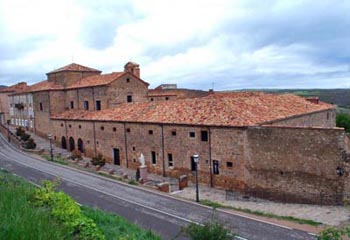
Immaculate Conception Convent in Agreda |
In a letter of May 1631 he wrote to the Father General:
“She told me all we know that has happened to our brothers and fathers, Fray Juan de Salas and Fray Diego Lopez, in their journey to the Jumanos. … She gave me their full descriptions, adding that she assisted them. She knows Captain Tuerto [a Jumano chief] very well, giving a detailed description of him and of the others.” He concluded, “She has preached in person our Holy Catholic Faith in every nation, particularly in our New Mexico. “
Fr. Benavides had other talks with Mother Mary of Jesus before he left. He became convinced that she was the “Lady in Blue” who had traveled to America to teach the Indians. It was not just her words, but her way of being that impressed him. He had formed a high opinion of the sanctity and piety of that Conceptionist nun who was favored with many mystical gifts and would write The Mystical City of God: The Life of the Blessed Virgin Mary.
Bilocation to America
How did these mysterious transports to America take place? When Mother Mary of Jesus was questioned as to whether she was carried away bodily or in spirit, she said she did not know. What she knew was that she saw these lands and different tribes; she felt the change in climate and temperature; she experienced pain when the Indians turned on her and persecuted her. On one occasion it seemed to her that she distributed rosaries among the Indians. In fact, she had a number of rosaries with her in her cell, but later, coming out of her mystical state, she did not find them.
She was certain that her work in New Mexico among the Indians was not a delusion. In her humility, she affirmed repeatedly that she was inclined to believe an Angel passed in her form to catechize the Indians, as a sign from Our Lord of the effects of prayer.
This was not the opinion of the Prelates who examined her. They were convinced that she was transported bodily because of what was clearly manifested to all her senses on those occasions. Satisfied with the spirituality of the Abbess, Fr. Benevides confirmed the opinion of her confessor, stating that he believed she was carried bodily to New Mexico and Texas, where she catechized the Indians.
Her letter to the American missionaries
Before he left Agreda, Fr. Benevides asked Mother Mary of Jesus to write a letter to the missionaries to encourage them in their work.
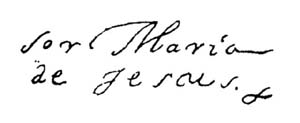
Mary of Agreda's signature on the letter addressed to the missionaries in America |
In it, she described other kingdoms of Indians that had not yet been discovered, and encouraged the friars to continue their blessed labors of conversion. She told the missionaries how pleasing and acceptable their work and sacrifices were to God. Even though she was privileged to bring the Religion of Christ to the Indians, she said, she did not have the great merit of the missionaries, who underwent such tremendous hardships and sufferings.
Our Lord was “highly pleased by the conversion of souls,” she wrote. “I can assure you that the Blessed Ones envy you, if envy could exist among them, which is impossible, but I am stating it thus according to our mode of expression. If they could forsake their eternal bliss to accompany you in those conversions, they would do it.” Such was the great value of saving souls won by the Precious Blood of Christ, she concluded.
This letter, which you can read in full here, was destined to inspire many Franciscan missionaries in their work among the Indians in the Southwest and California.
Continued

Posted February 5, 2010

Related Topics of Interest
 Mary of Agreda in America - Part I Mary of Agreda in America - Part I
 Testimonies of Mary of Agreda's Presence in the U.S. - Part III Testimonies of Mary of Agreda's Presence in the U.S. - Part III
 Who Was Mother Mary of Agreda? - Part IV Who Was Mother Mary of Agreda? - Part IV
 Catholicism in Colonial America Catholicism in Colonial America
 La Conquistadora: Our Country's Oldest Madonna La Conquistadora: Our Country's Oldest Madonna
 Ven. Antonio Margil of Jesus: Apostle of New Spain Ven. Antonio Margil of Jesus: Apostle of New Spain
 The First American Thanksgiving Was Catholic The First American Thanksgiving Was Catholic
 Pasquala of Mission Santa Inez Pasquala of Mission Santa Inez
 Pilgrims and Puritans Pilgrims and Puritans

Related Works of Interest
|
|
History | Home | Books | CDs | Search | Contact Us | Donate

© 2002-
Tradition in Action, Inc. All Rights Reserved
|
 |
|